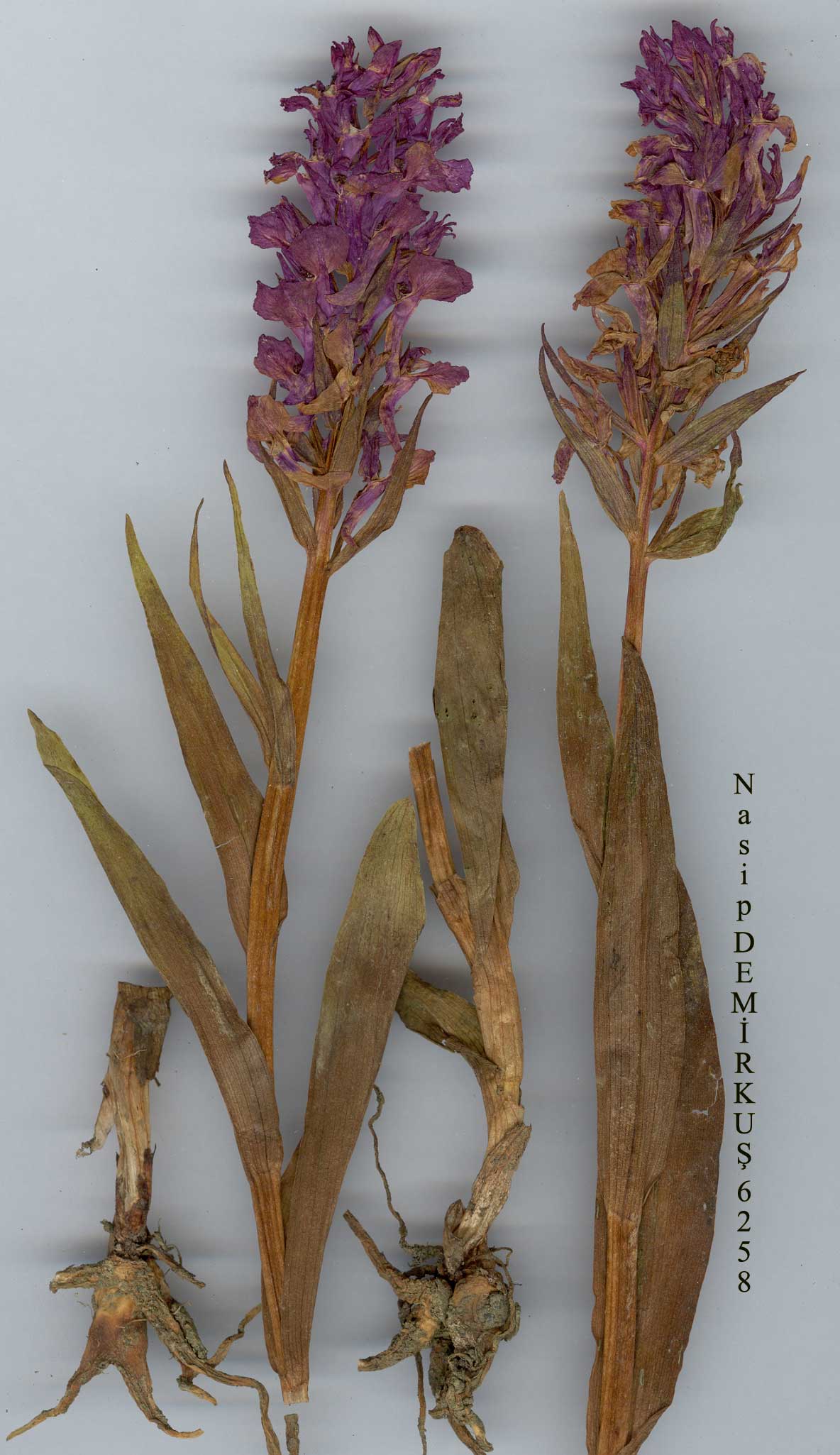| Orchidaceae |
|---|
 SOO_jpg.jpg)
Dactylorhiza iberica> (BIEB. EX WILLD.) SOO |
 Dactylorhiza iberica> (BIEB. EX WILLD.) SOO |
Dactylorhiza NECKER EX NEVSKI |
| D. iberica (Bieb. ex Willd.) Soó, Nom. Nov. Gen. Dactylorhiza, Budapest 3 (1962). Syn: Orchis iberica Bieb..ex Willd., Sp. PL 4:25 (1805) ;O.angustifolia Bieb., Ft Taur.-Cauc. 2:368 (İ808) nom. illegit. (O. iberica Willd. pro syn.); O. leptophylla C. Koch in Linnaea 22:282 (1849);O. natolica Fisch. & Mey. in Ann. Sci. Nat. ser. 4, 1:30 (1854). Ic: Nelson, op. cit. t. 80 (1976); Renz in Rech. fil., Fl. Iranica 126: t. 47, 48(1978). Map 103.
Plants slender, 20-40(-60) cm. Tubers napiform, tapering, usually 2-3-lobed near apex. Rootstock with subterranean stolons. Leaves erect, lanceolate-linear, lower broader. Spike narrowly cylindrical, rather lax. Bracts lanceolate, c. as long as ovary. Flowers rose-pink. Sepals and petals converging into a loose hood; sepals ovate-lanceolate, petals narrower. Labellum flat, ± fan-shaped to broadly ovate, shortly 3-lobed, rarely entire, 8-11 mm, with darker dots and lines; lateral lobes semi-ovate, margins ±crenulate; middle lobe small, sometimes tooth-like. Spur slender, pendent, c. i x ovary. Fl. 5-7(-8). Wet meadows and marshes, by lakes and streams, nr springs, 900-2500 m. Type: [Caucasus] Habitat in Iberia, [Marschall von Bieberstein] (holo. B-Willd. 16829, iso. LE?). . Widespread, but rare in S.E.Anatolia. A2(E) Istanbul: Istanbul, Lady Lister. A3 Bohr. Abant G., 1400 m, D. 37135! A4 Bolu Yeniçağa G., W. of Gerede, H. &. E. Walter 914a. A5 Amasya:40km E.of Çorum towards Samsun, Jardine 373! A6 Sivas: Yildiz Da., Sariyer, 1800m, Apold et al. 202! A7 Gümüşane: Kelkit to Erzincan, 1750 m, Demiriz (ISTF 10946)! A8 Erzurum: Kop Da. pass, Bayburt to Aşkale, 2300 m, Renz 9122! A9 Çoruh: Ardanuç to Kordevan Da. (Artvin to Ardahan), 1450 m, D. 30117! B2 Kütahya: Murat Da. above Hamam, 1700-1800 m, Watson et al. 1967! B3 Konya: Sultan Da. nr Akşehir, 1100 m, Renz & Taub. 78.408! B4 Konya: Sultanchan (Sultanhani), 990 m, Tchibatcheff (type of O. natolica). B5 Kirşehir: Seyfe G., N. of Mucur, 1100 m, Sorger 81-1-26! B6 Maraş: d. Çardak, Kandil Da., 2100 m, D. 20241! B7 Tunceli: above Pülümür, 1900 m, D. 31594! B8 Erzurum :Karakilise to Davası, 1600 m, 11 viii 1916, Sapozhnikov & Schischkin. B9 Van: S.E. of Çuh pass, Hoşap to Başkale, 2500 m, Renz 6473! C2 Denizli;Honaz Da.,Kazikbeli pass, 1300 m, Sunderm. et al. 74.170! C3 Antalya: Çalbali Da., 1700 m, D. 15248! C4 Konya/Içel: Sertavul pass, Mut toKaraman,Guichard & Harvey TUR/22/60! C5 Adana: Pozanti, Siehe 1895:386! C6 Adiyaman: 1 km S. of Gölbaşi, 900 m, Taub. 76.431! C9 Hakkari: 2 km N.W. of Hakkari, 2000 m, Sorger 81-27-30! C10 Hakkari: 10 km S.E. of Başkale, 2 200 m, Sorger 81 -3 2-3! Eastern Greece, Crimea, Caucasia, Syria, Palestine, N. & W. Iran. E. Medit. element. Taxonomically rather isolated. It is often found growing in large clumps and very abundantly, due to the stolons. Sezik (Türkiye'nin salepgilleri ticari salep çeşitleri ve özellikle Muğla salebi üzerinde araştırmalar 24, 1967) records var. leptophylla (C. Koch) G. Camus et al {O. leptophylla C. Koch) from B9 Bitlis. Taking into consideration Koch'soriginal description and remarks (". . . möchte vielleicht O. iberica Lindl. (= O. angustifolia Bieb.) sein . . .") and our own observations on large populations, there is no doubt that var. leptophyila is only a minor variant of D. iberica. The same applies to O. leptophyila C. Koch var. laxa C. Koch (op. cit. 282, 1849), a plant with usually larger flowers. Neither is worthy of formal recognition. |